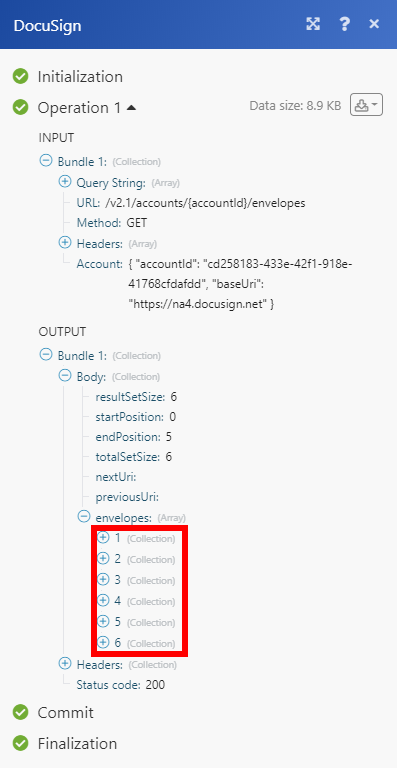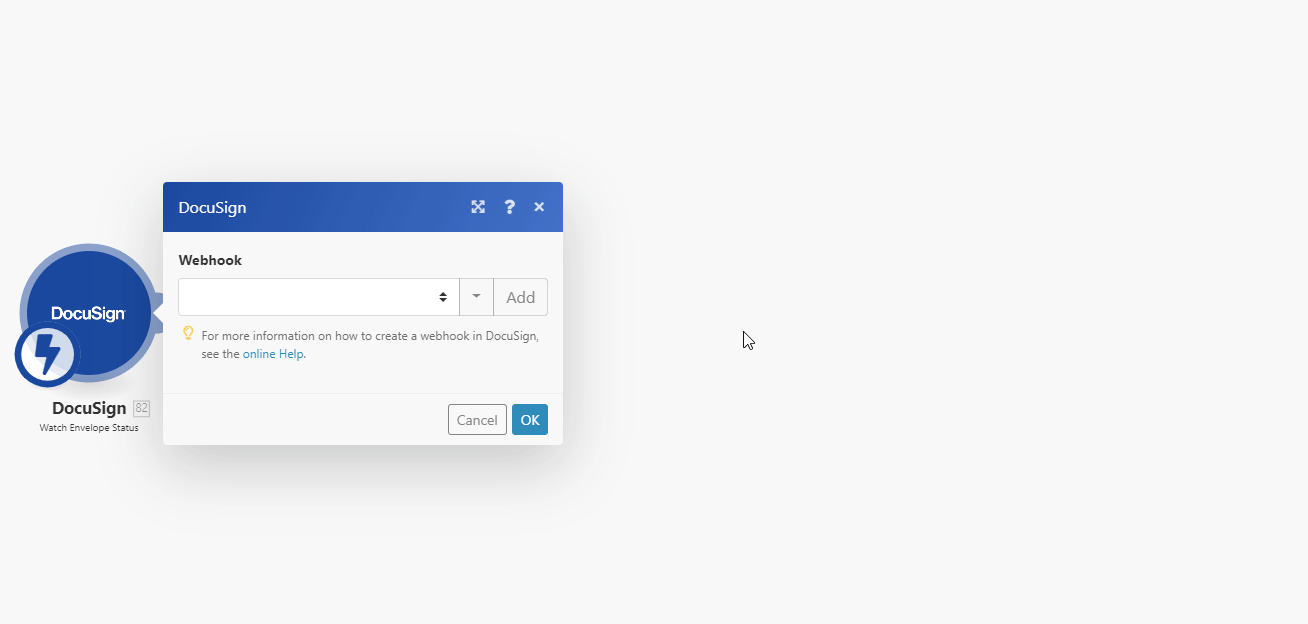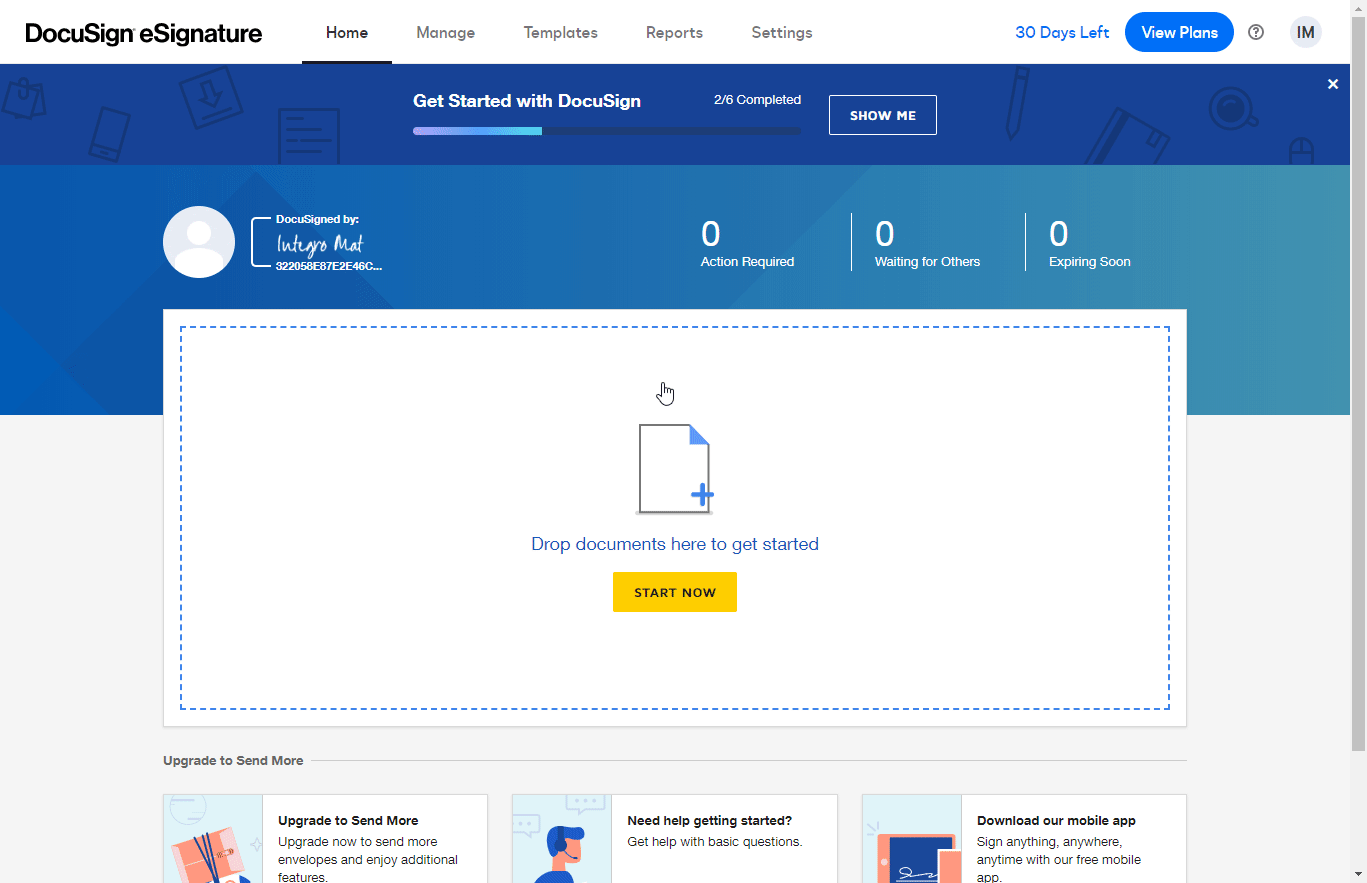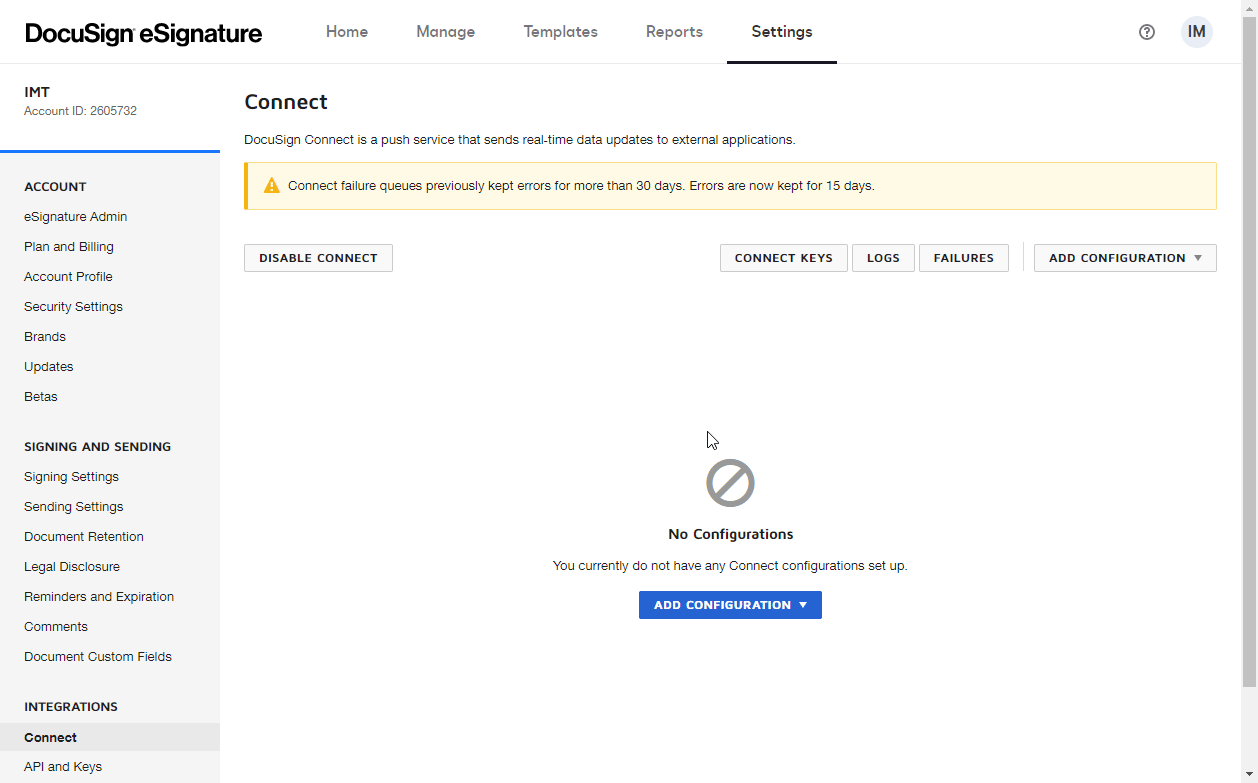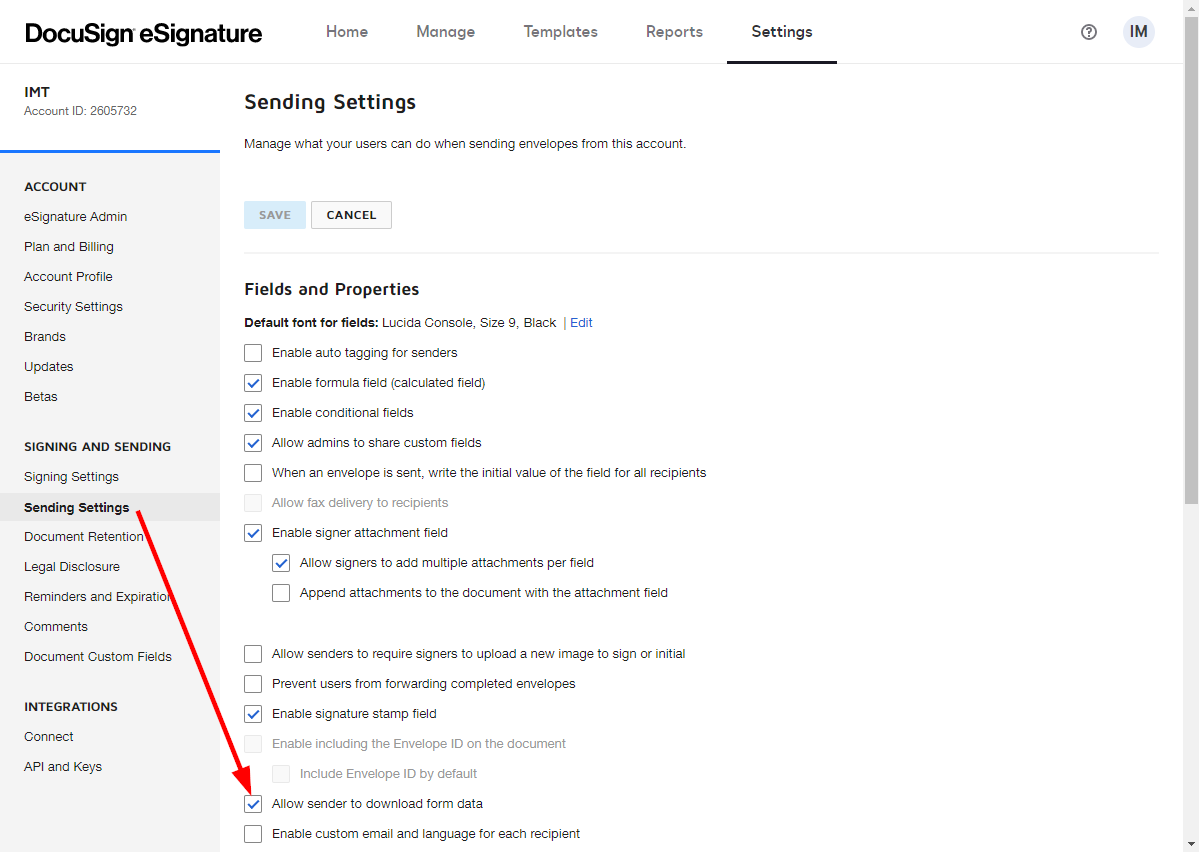| Active with remarks |
|---|
| This application needs additional settings. Please follow the documentation below to create your own connectionUnique, active service acces point to a network. There are different types of connections (API key, Oauth…). More. |
With DocuSign modulesThe module is an application or tool within the Boost.space system. The entire system is built on this concept of modularity. (module - Contacts) More in Boost.spaceCentralization and synchronization platform, where you can organize and manage your data. More IntegratorPart of the Boost.space system, where you can create your connections and automate your processes. More, you can monitor and retrieve envelope statusCreate statuses for each module separately to create an ideal environment for efficient and consistent work. More, search and retrieve envelopes, or download and send a document to sign in your DocuSign account.
To use DocuSign modules, you must have a DocuSign account. You can create an account at go.docusign.com/o/trial.
Refer to the DocuSign API documentation for a list of available endpoints.
To make the connection in Boost.space Integrator:
-
Log in to your Boost.space Integrator account, add a DocuSign moduleThe module is an application or tool within the Boost.space system. The entire system is built on this concept of modularity. (module - Contacts) More to your scenarioA specific connection between applications in which data can be transferred. Two types of scenarios: active/inactive. More, and click Create a connection.
Note: If you add a module with an
instanttag, click Create a webhookA webhook is a way for an app to send real-time information to a specific URL in response to certain events or triggers., then Create a connection. -
Optional: In the Connection name field, enter a name for the connection.
-
Optional: Click Show advanced settings and enter your custom app client credentials.
-
Click Save.
-
If prompted, authenticate your account and confirm access.
You have successfully established the connection. You can now edit your scenario and add more DocuSign modules. If your connection requires reauthorization at any point, follow the connection renewal steps here.
To create the DocuSign custom application and retrieve your client credentials:
-
Log in to your DocuSign account.
-
In the upper right, click Settings.
-
In the left menu, under Integrations, click Apps and Keys.
-
Click ADD APP AND INTEGRATION KEY.
-
Under App Name, click CREATE APP.
-
Under General Info, copy the Integration Key and store it in a safe place.
-
Under Authentication, click +ADD SECRET KEY and store it in a safe place.
-
Under Additional settings, for Redirect URIs, add
https://integrator.boost.space/oauth/cb/docusign -
Click Save.
You will use these values in the <Integration Key (Client ID) > and <Client Secret > fields in Boost.space Integrator.
TriggersEvery scenario has a trigger, an event that starts your scenario. A scenario must have a trigger. There can only be one trigger for each scenario. When you create a new scenario, the first module you choose is your trigger for that scenario. Create a trigger by clicking on the empty module of a newly created scenario or moving the... when an envelope changes its status.
![[Note]](https://docs.boost.space/wp-content/themes/bsdocs/docs-parser/HTML/css/image/note.png) |
Note |
|---|---|
|
This is available only for Business Pro DocuSign eSignature pricing plan and higher. |
The webhook URL needs to be generated in Boost.space Integrator and then added to DocuSign’s integrations settings.
-
Add the Watch Events module to your Boost.space Integrator scenario.
-
Generate and copy the webhook URL.
-
Log in to your DocuSign account.
-
Go to Settings > Connect.
-
Click Add Configuration, and select Custom.
-
Fill in the fields as follows:
Name
Enter the name of the webhook.
URL to Publish
Enter the webhook URL you have copied in step 2 above.
Include
Select the information that you want to include in the webhook.
TriggerEvery scenario has a trigger, an event that starts your scenario. A scenario must have a trigger. There can only be one trigger for each scenario. When you create a new scenario, the first module you choose is your trigger for that scenario. Create a trigger by clicking on the empty module of a newly created scenario or moving the... Events
Select events that will trigger the webhook and the Watch Events module in your Boost.space Integrator scenario.
-
Click the Add button (
 ) to save and close the dialog.
) to save and close the dialog.Now, every time the specified events occur in your DocuSign account, the Watch Events module in your Boost.space Integrator scenario is triggered.
Searches for envelopes by the filter settings.
|
Connection |
|
|
Account |
Select the account you want to search for envelopes. |
|
From Date |
Enter the date and time to start looking for status changes. |
|
To Date |
Enter the date and time to stop looking for status changes. |
|
Envelope IDs |
Add the envelope IDs to filter returned envelopes by. |
|
Transaction IDs |
Add the envelope transaction IDs to filter returned envelopes by. Transaction IDs are only valid for seven days. |
|
Status |
Select the envelope statusesCreate statuses for each module separately to create an ideal environment for efficient and consistent work. More you want to be included in the result. |
|
From To Status |
Select the envelope status that you are checking for. For example, if you select |
|
Search |
Enter the search term you want to use to filter the list of returned envelopes. |
|
Order |
Select whether you want to return envelopes in ascending or descending order. |
|
Order By |
Select the property you want to sort returned envelopes by. |
|
Limit |
Set the maximum number of envelopes Boost.space Integrator will return during one execution cycleA cycle is the operation and commit/rollback phases of scenario execution. A scenario may have one or more cycles (one is the default).. |
|
UserCan use the system on a limited basis based on the rights assigned by the admin. More Filter |
Returns envelopes where the authenticated user is the recipient, the sender, or the recipient only. |
|
Include in Response |
Select additional information to return about the envelopes.
|
Retrieves envelope details.
|
Connection |
|
|
Account |
Select the account that contains the envelope you want to retrieve details about. |
|
Envelope ID |
Enter (map) the ID of the envelope you want to retrieve details about. |
|
Include in Response |
Select additional information to return about the envelopes.
|
Downloads a specified document from the envelope.
|
Connection |
|
|
Account |
Select the account you want to download a document from. |
|
Envelope ID |
Enter (map) the ID or select the envelope that contains the document you want to download. |
|
Document ID |
Enter (map) the ID or select the document you want to download. |
|
Certificate |
Select the No option to exclude the envelope signing certificate from the download. |
|
Documents by User ID |
When the Yes option is selected, it allows the recipients to get documents by their user ID. For example, if a user is included in two different routing orders with different visibilities, using this option returns all of the documents from both routings. |
|
Encrypt |
When enabled, the PDF bytes returned in response are encrypted for all the key managersCan manage members and space managers, view and manage items. Can modify space settings. More configured on your DocuSign account. |
|
Show Changes |
When set to Yes, any changed fields for the returned PDF are highlighted in yellow, and optional signatures or initials are outlined in red. |
|
Watermark |
When set to Yes, the account has the watermark feature enabled, and the envelope is not complete, the watermark for the account is then added to the PDF documents. This option can remove the watermark. |
|
Language |
Select the language of the Certificate of Completion in the output. |
Downloads the envelope and field data from any in progress, completed, or canceled envelope that you sent or that is shared with you.
![[Note]](https://docs.boost.space/wp-content/themes/bsdocs/docs-parser/HTML/css/image/note.png) |
Note |
|---|---|
|
To use this module, go to DocuSign Settings > Sending Settings and enable the Allow sender to download form data option. Otherwise, the |
|
Connection |
|
|
Account |
Select the account that contains the envelope you want to retrieve the form data from. |
|
Envelope ID |
Enter (map) the ID of the envelope you want to retrieve the form data from. |
Sends a document to signers.
|
Connection |
|||||||
|
Account |
Select the account that contains the envelope with the document you want to send in order to be signed. |
||||||
|
Draft |
Enable this option to save the envelope as a draft. If disabled, the envelope will be sent to recipients. |
||||||
|
Signers |
Add the signers you want to send the document to.
|
||||||
|
Add Access Code |
Enable this option, and enter the code. If you enter a value, the recipient must enter the value as the access code to view and sign the envelope. Maximum Length: 50 characters, and it must conform to the account’s access code format setting. If blank, but the signer If blank, and the signer |
||||||
|
Note |
Enter a note that is sent to the recipient in the signing email. This note is unique to this recipient. In the user interface, it appears near the upper left corner of the document on the signing screen. Maximum Length: 1000 characters. |
||||||
|
Subject |
Enter the subject of the email used to send the envelope. |
||||||
|
Message |
Enter the content of the email blurb. |
||||||
|
Documents |
Add documents you want to send.
|
Creates and sends an envelope from a templateTemplates are predefined scenarios that you can expand and customize to create new scenarios. You can then share these with friends and colleagues. More.
|
Connection |
|||||||
|
Account |
Select the account that contains the envelope with the document template you want to send in order to be signed. |
||||||
|
Template |
Enter (map) or select the template you want to send a document from. |
||||||
|
Draft |
Enable this option to save the envelope as a draft. If disabled, the envelope will be sent to recipients. |
||||||
|
Subject |
Enter the subject of the email used to send the envelope. |
||||||
|
Message |
Enter the content of the email blurb. |
||||||
|
Template Recipients |
Add the signers of the document.
|
Allows you to perform a custom API call.
|
Connection |
||||
|
Account |
Select the account you want to make an API call for. |
|||
|
URL |
Enter a path relative to For example:
|
|||
|
Method |
Select the HTTP method you want to use: GET to retrieve information for an entry. POST to create a new entry. PUT to update/replace an existing entry. PATCH to make a partial entry update. DELETE to delete an entry. |
|||
|
Headers |
Enter the desired request headers. You don’t have to add authorization headers; we’ve already done that for you. |
|||
|
Query String |
Enter the request query string. |
|||
|
Body |
Enter the body content for your API call. |
The following API call returns envelopes from the specified date in your DocuSign account:
URL:
/v2.1/accounts/{accountId}/envelopes/
Method:
GET
Query String:
Key: from_date
Value: YYYY-MM-DD Specifies when the request begins checking for status changes for envelopes in the account.
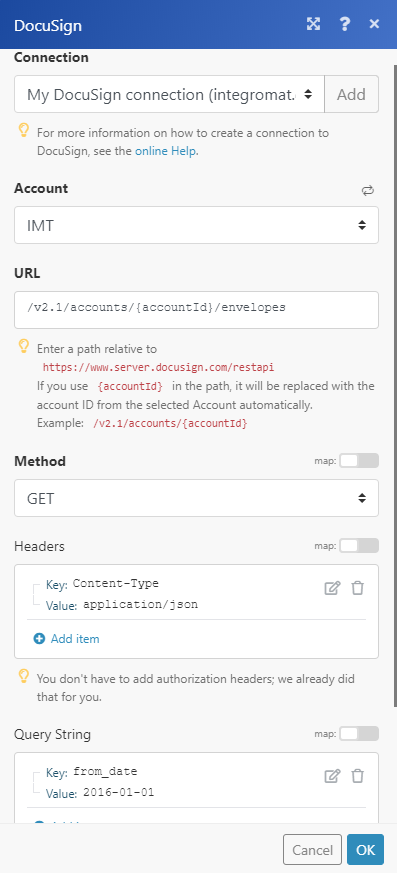 |
The result can be found in the module’s Output under BundleA bundle is a chunk of data and the basic unit for use with modules. A bundle consists of items, similar to how a bag may contain separate, individual items. More > Body > envelopes.
In our example, 6 envelopes were returned:
